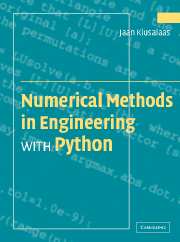Book contents
- Frontmatter
- Contents
- Preface
- 1 Introduction to Python
- 2 Systems of Linear Algebraic Equations
- 3 Interpolation and Curve Fitting
- 4 Roots of Equations
- 5 Numerical Differentiation
- 6 Numerical Integration
- 7 Initial Value Problems
- 8 Two-Point Boundary Value Problems
- 9 Symmetric Matrix Eigenvalue Problems
- 10 Introduction to Optimization
- Appendices
- Index
10 - Introduction to Optimization
Published online by Cambridge University Press: 05 June 2012
- Frontmatter
- Contents
- Preface
- 1 Introduction to Python
- 2 Systems of Linear Algebraic Equations
- 3 Interpolation and Curve Fitting
- 4 Roots of Equations
- 5 Numerical Differentiation
- 6 Numerical Integration
- 7 Initial Value Problems
- 8 Two-Point Boundary Value Problems
- 9 Symmetric Matrix Eigenvalue Problems
- 10 Introduction to Optimization
- Appendices
- Index
Summary
Find x that minimizes F(x) subject to g(x) = 0, h(x) ≥ 0
Introduction
Optimization is the term often used for minimizing or maximizing a function. It is sufficient to consider the problem of minimization only; maximization of F(x) is achieved by simply minimizing – F(x). In engineering, optimization is closely related to design. The function F(x), called the merit function or objective function, is the quantity that we wish to keep as small as possible, such as cost or weight. The components of x, known as the design variables, are the quantities that we are free to adjust. Physical dimensions (lengths, areas, angles, etc.) are common examples of design variables.
Optimization is a large topic with many books dedicated to it. The best we can do in limited space is to introduce a few basic methods that are good enough for problems that are reasonably well behaved and don't involve too many design variables. By omitting the more sophisticated methods, we may actually not miss all that much. All optimization algorithms are unreliable to a degree—any one of them may work on one problem and fail on another. As a rule of thumb, by going up in sophistication we gain computational efficiency, but not necessarily reliability.
The algorithms for minimization are iterative procedures that require starting values of the design variables x. If F(x) has several local minima, the initial choice of x determines which of these will be computed.
- Type
- Chapter
- Information
- Numerical Methods in Engineering with Python , pp. 381 - 408Publisher: Cambridge University PressPrint publication year: 2005

